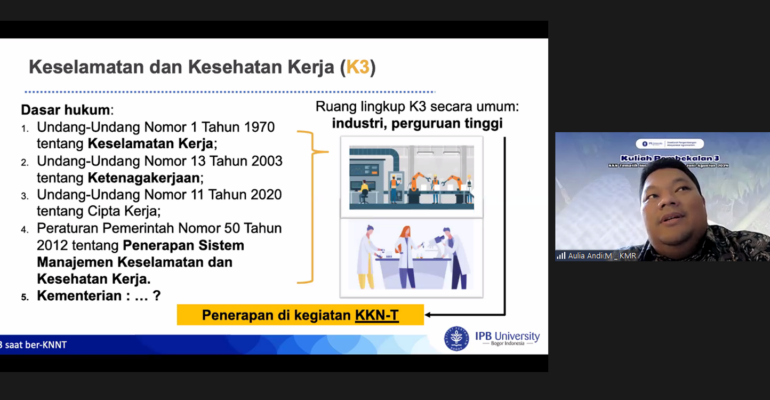Approaching KKNT Innovation, IPB University Emphasises K3 Material in the Last Debriefing Lecture

The series of debriefings for IPB University’s Thematic Real Work Lecture (KKNT) Innovation programme for the June-August 2024 period has been completed. In the last debriefing lecture (4/5), KKNT Inovasi students received debriefing related to occupational health and safety (K3) material.
Dr drh Aulia A Mustika, Chief of Occupational Safety and Health, IPB University Risk Management Office provided material related to Occupational Health and Safety (K3). Given that there are several hazardous conditions that can be encountered by KKNT Inovasi students while carrying out activities at the location.
These hazardous conditions vary according to the typology of the area where the KKNT Innovation students are located. Hazards that can be encountered include human error and health risk, namely the potential risk of accidents caused by other drivers, falling, or contracting diseases.
Potential hazardous situations and locations, for example in farm locations that have the risk of being bitten, chased by animals, kicked by livestock, and zoonosis or contracting diseases from animals to humans or vice versa. This is different from the potential risks that will arise in locations dominated by forests, namely getting lost, falling, being disturbed by wildlife, insect disturbances, and psychosocial problems.
“Furthermore, horror events or invisible creatures that appear during students’ KKNT Innovation, can cause psychosocial impacts, such as thoughts and sleeplessness. So it is necessary to ask the community to avoid haunted areas and find solutions to deal with this incident,” said drh Aulia.
For this reason, she said, students must prepare themselves to face hazards by preparing personal protective equipment (PPE) to isolate part or all of the body from potential hazards in the workplace. Some common PPE such as riding helmets, gloves, masks, safety shoes, field clothes, lab coats, raincoats are also needed as needed.
“This PPE is adjusted, if there is no potential danger in the place, there is no need to use PPE. But when there is a mild source of danger, only a lot of dust, it is enough to use a mask. For example, if there is a heavier construction project, it means you need to use a safety helmet and boots, and use a driving helmet when using a motorbike,” added Dr Aulia.
In addition, first aid kits and personal medication need to be prepared, such as asthma medication, heart medication, allergy medication, and others. A first aid kit should ideally contain 20 to 21 items in accordance with the standards of the Ministry of Manpower and the Ministry of Health. An understanding of the use of fire extinguishers is also needed to help rescue residents in the event of emergency situations and conditions.
He also emphasised driving safety, as it concerns the mobility of students at the KKNT Inovasi location who will use motorised vehicles. Therefore, he advised, students need to check the completeness of motorbike standards and functions and reduce human error factors, such as drowsiness and using gadgets while driving.
In addition to K3 material, the briefing this time was also filled by Dr Salundik (Lecturer at the Faculty of Animal Science, IPB University) related to household and livestock waste management techniques and agroforestry material by Bima Krida Pamungkas (Head of Decarbonisation PT Astra International Tbk). (*/Rz) (IAAS/RUM)



